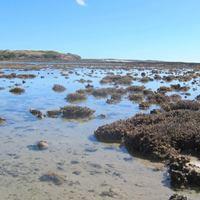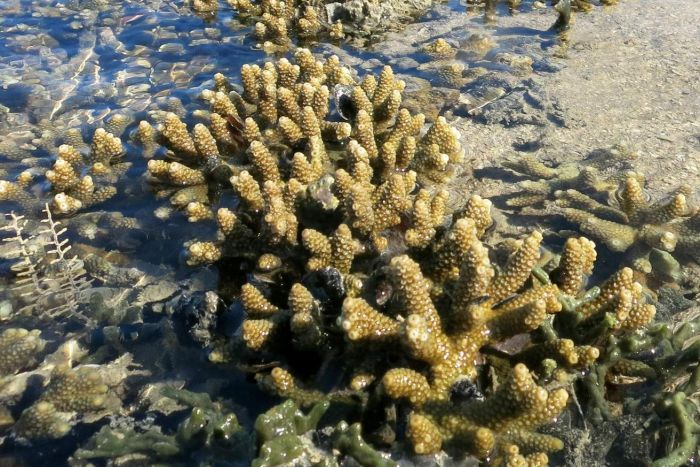
WAMSI’s Kimberley Marine Research Program has provided the first definitive evidence that the region’s fringing coral reefs are long lived features growing over a two-billion-year-old land surface recording changes through post-glacial time and dispelling the theory that the reefs are thin veneers over bedrock.
The findings, published in the Australian Journal of Maritime and Ocean Affairs, make significant inroads into understanding the poorly known coral reefs of the Kimberley in an area that is considered an internationally significant ‘biodiversity hotspot’.
Co-author of the paper, Curtin University’s Mick O’Leary, said the project is working to determine just how unique the Kimberley reef system is.
“We hope to establish whether Kimberley reef morphology conforms to established geomorphic models, like the Great Barrier Reef,” Dr O’Leary said. “It may be that the reefs have developed their own distinctive morphologies driven by extreme environmental conditions, like the massive 11 metre tides that are unique to the Kimberley.”
The research team used a combination of remote sensing, sub-bottom profiling and associated sedimentological work to produce a regional geodatabase of coral reefs and to determine the internal architecture and growth history of the coral reefs over the last 12,000 years.
More than 860 nearshore reefs were mapped from Cape Londonderry to Cape Leveque with a total of 30 reefs studied in detail and their substrates documented across the Kimberley Bioregion.
The prevalence of rhodolith dominated substrates on high intertidal reefs (both planar and fringing reefs) contrasts with the more coral dominated fringing reefs, with inner to mid-shelf planar reefs having some shared attributes with these contrasting categories.
 |
| Satellite images used to map intra-reef geomorphology and associated substrates for the targeted reefs of this study:
(a) Bathurst and Irvine Islands; (b) Cape Londonderry; (c) Montgomery Reef; (d) Maret Island; (e) Adele Reef; (f) Long Reef; (g) Molema Island; and (h) Tallon Island. |
Over 294 km of sub-bottom profiling records were aquired from a representative suite of reefs to determine reef growth history.
Two seismic horizons were identified in the inshore reefs (Sunday Islands, Molema Island, Montgomery Reef and the Buccaneer Archipelago, where seismic calibration was available), marking the boundaries between Holocene reef (Marine Isotope Stage 1, MIS 1, last 12 ky) commonly 10 – 15 m thick, and MIS 5 (Last Interglacial, 120 ky; LIG) and Proterozoic rock foundation over which Quaternary reef growth occurred. In the offshore reefs of the Adele Complex, two additional deeper acoustic reflectors were identified (possibly MIS 7 and MIS 9 or 11)
 |
| SBP images of the NW channel bank complex associated with North Turtle Reef |
The transition of reef building organisms was investigated by shallow coring (up to 6 m) providing the first subsurface sedimentary samples for the key types of reef found in the southern Kimberley.
The core study sheds considerable light on the growth history of the reefs and has shown that the inshore reefs are muddy in character, similar to the Cockatoo island fringing reef.
Adele Reef, offshore, is distinctly sandier in character. Radiocarbon dating showed that, like Cockatoo Island, reef growth initiated soon after the inner shelf was flooded (~10,000 years ago).
Early reef buildups are likely to be muddy with branching, plate, and massive corals. This is replaced on many reefs (particularly exemplified by Montgomery and Turtle Reefs) by coralline red algae (rhodoliths), small robust corals and coral rubble as reefs become intertidal at their surface.
Multibeam surveys of reef flats discovered a new reef morphotype, the “High Intertidal Reef” which are uniquely characterised by having reef flats that have a surface elevation that sits above the level mid-tide level. Typically reef flats sit at the level of mean low water spring tide.
 |
| Getting ready for coring with help from Bardi Jawi Rangers and Erin McGinty from KMRS. |
The project’s findings have been integrated into a GIS based database called ‘ReefKIM’ which incorporates a wide range of datasets, including remote sensing images, bathymetric charts, site photos and many geological and biological datasets into one inclusive geodatabase.
The main purpose of ReefKIM is to compile various types and sources of reef and marine environment-related information, fostering data fusion and maximising the accessibility of important information to better understand the Kimberley reefs.
It is intended to provide researchers with an overview of essential information on the Kimberley reefs. It also constitutes a significant decision-support tool, providing managers and stakeholders with practical information for the implementation of their plans and will also help shape the direction of future management policies of the Kimberley region.
Crowdsourcing new information into ReefKIM (also known as the ‘citizen science’ approach) is a promising method for filling knowledge gaps and enhancing understanding of complex reef ecosystems.

Methodological scheme of data acquisition, processing, integration and storage for the Kimberley reef geodatabase (ReefKIM) (source: Kordi et al., 2016).
“Satellite image analysis has revealed that fringing reefs in the Kimberley bioregion grow very well and differ geomorphologically from middle-shelf planar reefs both inshore and offshore,” Dr O’Leary said.
“The acoustic mid-shelf reef (Adele complex) profiles marked boundaries between Holocene reef (last 12,000 years) and MIS 5 (last 125,000 years) and an ancient Neoproterozoic rock (1,000 to 541 million years ago).
“Correlating the seismic data with the reef chronology determined in Cockatoo and Adele Island, it has been possible to highlight the evolution of multiple stages of reef building, stacked by repeated high sea levels (Adele, 3 stages, at least; Sundays Group, Buccaneer Archipelago and Montgomery Reef, 2 stages; some patch reefs, 1 stage).
“What we’ve found is that the foundation over which reef growth occurred is the two-billion-year-old land surface seen in many Kimberley islands composed of Neoproterozoic rocks. That confirms that Kimberley reefs are not thin growths over bedrock,” Dr O’Leary said.
The findings provides a better understanding of the Kimberley reefs and demonstrate their capacity to succeed in challenging environments while generating complex habitats to support diverse species.
Research Articles:
Collins, L.B., O’Leary, M.J., Stevens, A. M., Bufarale, G., Kordi, M., Solihuddin, T, 2015. Geomorphic Patterns, internal architecture and Reef Growth in a macrotidal, high turbidity setting of coral reefs from the Kimberley Bioregion. Australian Journal of Maritime & Ocean Affairs, Volume 7, Issue 1, pp 12-22. (open access from Nov 2017)
Moataz N. Kordia, Lindsay B. Collins, Michael O’Leary, Alexandra Stevensa (November 2015) ReefKIM: An integrated geodatabase for sustainable management of the Kimberley Reefs, North West Australia Ocean & Coastal Management doi:10.1016/j.ocecoaman.2015.11.004
The $30 million Kimberley Marine Research Program is funded through major investment supported by $12 million from the Western Australian government’s Kimberley Science and Conservation Strategy co-invested by the WAMSI partners and supported by the Traditional Owners of the Kimberley.
Category:
Kimberley Marine Research Program































